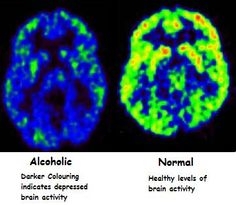How does alcohol affect your brain?
Submitted by Francis Heber Gonzalez on
Alcohol consumption has some benefits: helps us relax and generally makes us have a good time. But not everyone has the same relationship with alcohol. There are some people who are more affected by alcohol consumption than others, either because of genetic predispositions, the environment they grew up in or behaviors they observed. Although for some, the two or three drinks on a Friday is no more than an escape without much consequence, for others it can be a sentence to constant suffering.
The ethanol molecule, the type of alcohol in alcoholic beverages, is mostly metabolized by the liver. However, there is a certain amount that is incorporated directly into the bloodstream and it eventually affects the brain and its functions. This makes alcohol consumption affect motor functions, speech, judgment, inhibitions and sexual performance, among others. But how can a molecule composed of 2 carbon, 6 hydrogen, and one oxygen atom affect you in so many different ways?
The brain is the command center of the body. When you drink alcohol, it can cross the blood-brain barrier (the border that separates the bloodstream from the fluid that bathes the nervous system). Not all molecules in our blood can pass through this barrier, but ethanol is one of them. This implies that the ethanol molecule may interfere with neurotransmission, the communication between neurons, and therefore, the functions that are controlled by the brain, from the heartbeat to our breathing.
Studies have shown that there are receptors in the brain that are especially sensitive to alcohol. These are called GABA receptors and are found in greater amounts in certain areas of the brain, including the prefrontal cortex, cerebellum, and hypothalamus.
The GABA neurotransmission system promotes inhibition. Generally speaking, alcohol takes the place of the molecule of GABA and bind to the receptor, generating the aforementioned effects. If GABA levels are stable but ethanol is added to the system, the inhibition will increase.
How does this happen?
The effects we observe depend on our level of consumption and the area of the brain that is affected. For example, the famous "blackouts", occur when ethanol interacts with GABA receptors in the hippocampus, region responsible for generating memories. When this region is inhibited it is more difficult to remember where you left the cell phone, wallet or keys the night before.
Similarly, when ethanol interacts with GABA receptors in neurons of the cerebellum, structure responsible for maintaining coordination and balance, you can’t walk in a straight line and you may even fall face first. When alcohol affects the prefrontal cortex, responsible for our judgment, decision making is affected, inhibitions reduced, and pain tolerance increased .
Beyond these short-term consequences, consumption of alcoholic beverages by people with mental health conditions are particularly detrimental for these individuals. People suffering from depression, anxiety, or bipolar disorder are especially vulnerable to the effects of alcohol on the brain. This is because their health conditions already predispose them to severe consequences if there’s any imbalance in their system of chemical messengers in the brain. So consuming alcohol has an additive effect.
For example, benzodiazepines such as Xanax and Valium taking by those suffering from anxiety, when combined with alcohol, can enhance inhibition and can lead to respiratory or cardiac arrest as the central nervous system is inhibited to a point that not even these functions can be performed. On the other hand, if these people drink alcohol instead of taking their medications, the treatment will lose some effectiveness because in essence they are self-medicating with alcohol and this behavior can lead to dependence.

Figure 1. In addition to GABA itself, other compounds can interact with different parts of the GABA receptors in neurons.
With bipolarity, which consists of episodes of depression followed by episodes of excitement or mania, drinking alcohol can increase the intensity and duration of the episodes. Alcohol consumption also increases hormone levels, specifically, that of norepinephrine, a hormone that controls blood sugar levels and our response to stress, among other things, causing excitation. Therefore, those who are going through a manic episode in their condition’s cycle can enhance this effect when consuming alcohol, leading them to act as "Superman" or feeling indestructible because their levels of norepinephrine are elevated.
Conversely, those going through an episode of depression, consuming alcohol may inhibit further their system, which makes them sedentary individuals, unmotivated and may increase rumination, obsessive thoughts on an issue or problem, which in turn can increase the chances of a suicide attempt.
The important thing is that if you like to consume alcohol, know what type of drinker you are and how alcohol affects you. Not only for your health and well-being, but also for those around you, your family and friends, who are the ones who have to take care of you when you can’t control your consumption. #porunPuertoRicosaludable To your health!
References
-
How alcoholism works: Alcohol and the brain. Retrieved April 7th, 2016. http://science.howstuffworks.com/life/inside-the-mind/human-brain/alcoholism4.htm
-
Alcohol and neurotransmitter interactions. C. Fernando Valenzuela. Alcohol Health and Research World. Retrieved April 7th, 2016. http://pubs.niaaa.nih.gov/publications/arh21-2/144.pdf
-
Alcohol and your brain. Retrieved April 8th, 2016. http://sciencenetlinks.com/student-teacher-sheets/alcohol-and-your-brain/
-
Communications networks in the brain. Figure 4. Retrieved April 30, 2016. http://pubs.niaaa.nih.gov/publications/arh313/196-214.htm
Categories (Educational Resources):
- Texto Alternativo
- Blogs CienciaPR
- Biología
- Salud
- Biología (superior)
- Ciencias Biológicas (intermedia)
- Salud (Intermedia)
- Salud (Superior)
- Text/HTML
- CienciaPR
- English
- MS. Growth, Development, Reproduction of Organisms
- 6to-8vo- Taller 2/3 Montessori
- 9no-12mo- Taller 3/4 Montessori
- Blog
- Educación formal
- Educación no formal









